MARK BANDO'S WEBSITE
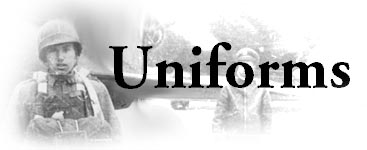
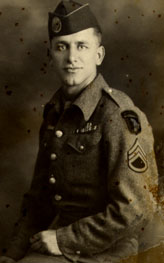 While in the UK before and after the Normandy Invasion, some 101st troopers acquired Commonwealth battle jackets and wore them with the addition of American insignia. Shown above in a London studio portrait, is S/Sgt C.A. Mitchell, a platoon sgt of B/506th. The reverse of the photo bears the date 1 August, 1944. I've also heard of a British battle jacket being worn by Alex Haag of HQ/1 501 PIR, and there is an example from a 101st glider trooper in the collection of the Don Pratt Museum at Ft Campbell. I suspect some of these jackets were worn by troopers upon discharge from British hospitals, as they may have been more readily available than American Class A's at the time. Most wounded troopers had their jumpsuits cut off by medical personnel and tossed in the trash. At any rate, C.A. Mitchell passed-on a decade ago, several years after giving me this photo.
While in the UK before and after the Normandy Invasion, some 101st troopers acquired Commonwealth battle jackets and wore them with the addition of American insignia. Shown above in a London studio portrait, is S/Sgt C.A. Mitchell, a platoon sgt of B/506th. The reverse of the photo bears the date 1 August, 1944. I've also heard of a British battle jacket being worn by Alex Haag of HQ/1 501 PIR, and there is an example from a 101st glider trooper in the collection of the Don Pratt Museum at Ft Campbell. I suspect some of these jackets were worn by troopers upon discharge from British hospitals, as they may have been more readily available than American Class A's at the time. Most wounded troopers had their jumpsuits cut off by medical personnel and tossed in the trash. At any rate, C.A. Mitchell passed-on a decade ago, several years after giving me this photo.
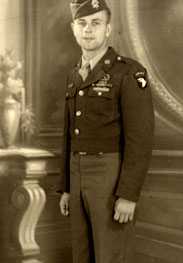 In 1945, when 4 pocket blouses were no longer acceptable for Class 'A uniform purposes, many men had their blouse cut down to Ike jacket length, as demonstrated here by Headrick Smith of HQ/2, 501 PIR. These shortened blouse conversions can be easily recognized by several readily visible features: 1) The brass buttons-normal Ike jackets had plastic buttons which were also concealed. 2) No pleats on the chest pockets. 3) plain wrists without the button cuffs found on an Ike jacket
In 1945, when 4 pocket blouses were no longer acceptable for Class 'A uniform purposes, many men had their blouse cut down to Ike jacket length, as demonstrated here by Headrick Smith of HQ/2, 501 PIR. These shortened blouse conversions can be easily recognized by several readily visible features: 1) The brass buttons-normal Ike jackets had plastic buttons which were also concealed. 2) No pleats on the chest pockets. 3) plain wrists without the button cuffs found on an Ike jacket
IKE JACKET
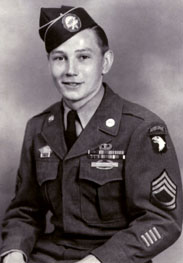 In this 1945 studio portrait, Lou Peterson of C/506th models his Eisenhower jacket. This jacket featured short-waisted design, with two pleated chest pockets.
The 101st Airborne received them in spring, 1945, after the Presidential Unit Citation review in mid-March. The 506th was in Southern Germany in April, 1945, on the road to Berchtesgaden, when these jackets were issued to them. Originally designed to be a battle jacket, the Ike was used instead as a walking-out uniform and became the new Class'A' attire, replacing the earlier 4 pocket blouse.
In this 1945 studio portrait, Lou Peterson of C/506th models his Eisenhower jacket. This jacket featured short-waisted design, with two pleated chest pockets.
The 101st Airborne received them in spring, 1945, after the Presidential Unit Citation review in mid-March. The 506th was in Southern Germany in April, 1945, on the road to Berchtesgaden, when these jackets were issued to them. Originally designed to be a battle jacket, the Ike was used instead as a walking-out uniform and became the new Class'A' attire, replacing the earlier 4 pocket blouse.
photo courtesy Kurt Barickman collection.
SIMMONS' JACKET
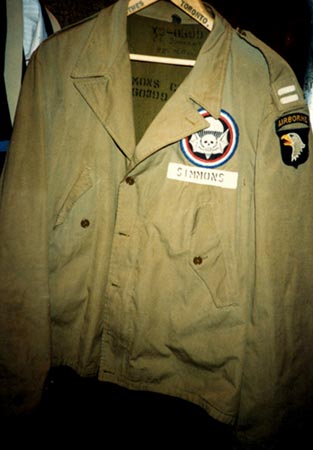 M38 'Kitty Parsons' Jacket of Captain Cecil L. Simmons, Co. H, 502 PIR. This blanket-lined field jacket differed from the later M41 jacket only in the pocket flaps on
the side slash pockets. This specimen is adorned with a name tape, Type 6 U.S. made eagle patch, and rank bars made of small pieces of parachute suspension line, ironed-flat, and machine- sewn onto the shoulders by the Riggers. This was done frequently for officers in the 502. The bat wings and skull regimental patch, later known as the 'Widow Maker' insignia, is on the left chest. The eagle patch originally had a white tongue but the tongue was colored red with a pen. Simmons said this was common practice among his men, who didn't like the white-tongued patches. These patches had no significance, but were merely a manufacturer's variation-possibly during a factory shortage of red thread. One British patch manufacturer, thinking that there was some significance to the white tongued patches, did imitate them in a cotton on wool variant. However Simmons'M42 Normandy jumpsuit, also in my collection, does have an unaltered white-tongued patch on the shoulder. Note also, the name and serial number stenciled inside the back of the jacket.
M38 'Kitty Parsons' Jacket of Captain Cecil L. Simmons, Co. H, 502 PIR. This blanket-lined field jacket differed from the later M41 jacket only in the pocket flaps on
the side slash pockets. This specimen is adorned with a name tape, Type 6 U.S. made eagle patch, and rank bars made of small pieces of parachute suspension line, ironed-flat, and machine- sewn onto the shoulders by the Riggers. This was done frequently for officers in the 502. The bat wings and skull regimental patch, later known as the 'Widow Maker' insignia, is on the left chest. The eagle patch originally had a white tongue but the tongue was colored red with a pen. Simmons said this was common practice among his men, who didn't like the white-tongued patches. These patches had no significance, but were merely a manufacturer's variation-possibly during a factory shortage of red thread. One British patch manufacturer, thinking that there was some significance to the white tongued patches, did imitate them in a cotton on wool variant. However Simmons'M42 Normandy jumpsuit, also in my collection, does have an unaltered white-tongued patch on the shoulder. Note also, the name and serial number stenciled inside the back of the jacket.
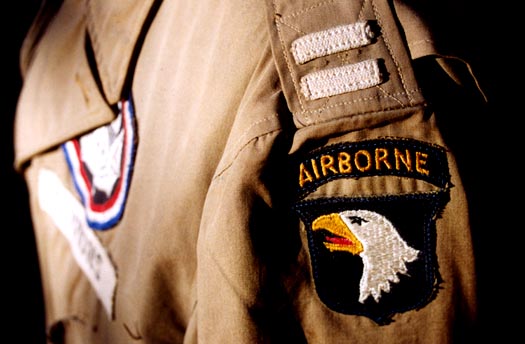
DELONG'S JACKET
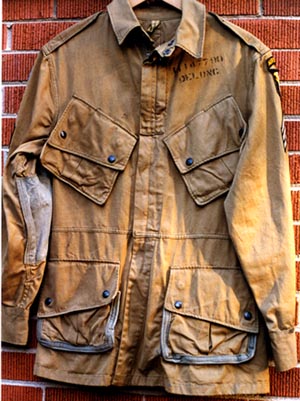 Several years ago, I acquired an M42 reinforced jump jacket from Jim Colucci, a veteran of H/502. Jim told me he won a drawing to come to the states on a War Production tour, shortly after the Bastogne campaign. Like others, Jim had turned-in his M42 jumpsuit, to be replaced by rigger-modified M43s. But he wanted a tan jumpsuit to wear during the Tour. He
entered a building full of barracks bags belonging to men who were KIA or MIA. Opening one at random, he found this jacket, but was not familiar with the original owner, a 'Delong'.
Several years ago, I acquired an M42 reinforced jump jacket from Jim Colucci, a veteran of H/502. Jim told me he won a drawing to come to the states on a War Production tour, shortly after the Bastogne campaign. Like others, Jim had turned-in his M42 jumpsuit, to be replaced by rigger-modified M43s. But he wanted a tan jumpsuit to wear during the Tour. He
entered a building full of barracks bags belonging to men who were KIA or MIA. Opening one at random, he found this jacket, but was not familiar with the original owner, a 'Delong'.
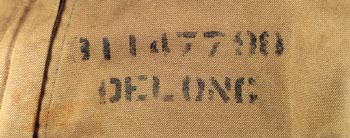
When I acquired the jacket, I wasn't certain if the original owner was even a 'Deuce' man, or what had been his fate. There was a Frank Delong in A/501, another Delong in 506th, and a Charles Delong in 502. But none of these men were listed as killed in action. In a Dutch book called 'Vanished Cemeteries', I found a Charles Delong from Bridgewater, ME, who had died in Holland on 15 November, 1944, at Hien. The serial number matched the one stenciled on the chest and the inside back of the jacket. A regimental designation of 502 was given.
Now to learn more about the man. I eventually learned that Delong was a medic and finally that he was attached to various 3rd Bn companies, although Colucci had never met him. 502 Medic Patrick Callery, who is pictured below, standing next to Delong (Delong is wearing the jeep cap), told me that Delong was a former Canadian citizen, whose family had crossed the border into Maine. Delong was tall and thrifty. From other medics like Louis Mete, I learned that Delong and a S/Sgt Bryant had accepted wine from a Dutch citizen near Dodewaard, Holland and both became ill and died several days later, presumably of poisoning. This is why Delong is not listed with the Killed In Action in the back of Rendezvous With Destiny, the divisional history. Mete, who visited Delong in the hospital, was able to hear the story from the dying soldier.
Regarding the M42 jacket, the belt had been deliberately removed as was so often done, to avoid interference with the web waist belt, and a Type 3 U.S. made 101st patch is affixed to the left shoulder. The buck Sgt stripes were added by Colucci to wear on the tour; Delong had been a Pfc. The photo below right, shows Jim Colucci in 1945. His Class 'A' blouse, also in my collection, also bears the serial number of another soldier, who has not been identified. As uniforms frequently got mixed-up at the laundry, it was common for men to wind-up with garments which had originally been issued to others. This blouse also bears a Type B-1, British-made eagle patch.
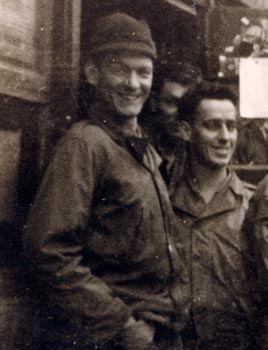
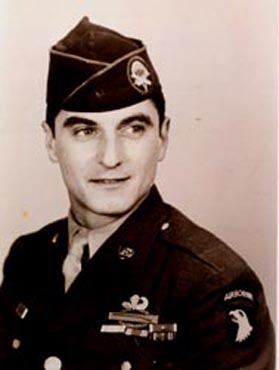
photos courtesy Pat Callery and Jim Colucci
Officers' Flight Jacket, Type A-2
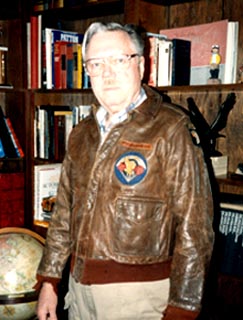 Lt Albert Hassenzahl was with Company 'C' 506th from beginning to end, first as a platoon leader, then as company commander. In this 1988 photo, Al is wearing his A-2 flight jacket with 101st Airborne SSI, 506th 'Para Dice' pocket patch, and a leather name tape with his name stenciled on, in black paint. Hassenzahl was highly decorated, the recipient of four Purple Hearts and a Silver Star Medal.
Lt Albert Hassenzahl was with Company 'C' 506th from beginning to end, first as a platoon leader, then as company commander. In this 1988 photo, Al is wearing his A-2 flight jacket with 101st Airborne SSI, 506th 'Para Dice' pocket patch, and a leather name tape with his name stenciled on, in black paint. Hassenzahl was highly decorated, the recipient of four Purple Hearts and a Silver Star Medal.
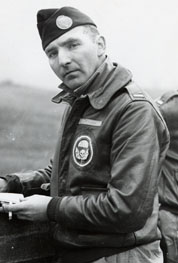 In this 1944 photo, Captain George Buker, Regimental S-2 officer of the 502 PIR, posed for Mike Musura on a bridge in England before D-day. He wears a choice example of an A-2 flight jacket, bearing a leather disc with a decal (simulating paint), of the unauthorized bat wings and skull design of the 502 PIR.
photo c/o Nadine W.
In this 1944 photo, Captain George Buker, Regimental S-2 officer of the 502 PIR, posed for Mike Musura on a bridge in England before D-day. He wears a choice example of an A-2 flight jacket, bearing a leather disc with a decal (simulating paint), of the unauthorized bat wings and skull design of the 502 PIR.
photo c/o Nadine W.
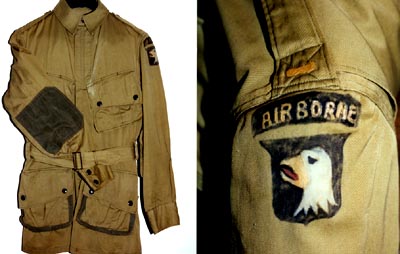 This rigger modified M42 jacket belonged to Lt Thomas A. Rhodes
of F/506th. Of note is the unique eagle SSI which was painted on. This jacket is in a private collection in New England.
This rigger modified M42 jacket belonged to Lt Thomas A. Rhodes
of F/506th. Of note is the unique eagle SSI which was painted on. This jacket is in a private collection in New England.
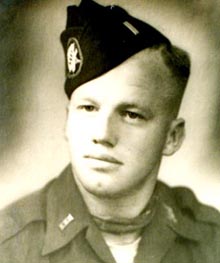
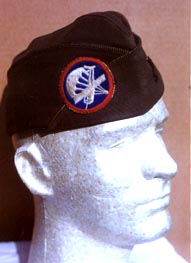 The photo at left shows Lt Doyle Roberts, a jump qualified member of B/326th Airborne Engineeer Bn., wearing his officers' overseas cap with black and gold piping. What is unusual is that his paraglide overseas cap patch is sewn-on such that the Glider depicted on it is headed nose down toward the ground. This was his opinion of Gliders. The image at right is a contemporary photo of Lt Roberts' cap. Officers could get away with such expressions of individual opinion.
The photo at left shows Lt Doyle Roberts, a jump qualified member of B/326th Airborne Engineeer Bn., wearing his officers' overseas cap with black and gold piping. What is unusual is that his paraglide overseas cap patch is sewn-on such that the Glider depicted on it is headed nose down toward the ground. This was his opinion of Gliders. The image at right is a contemporary photo of Lt Roberts' cap. Officers could get away with such expressions of individual opinion.


















